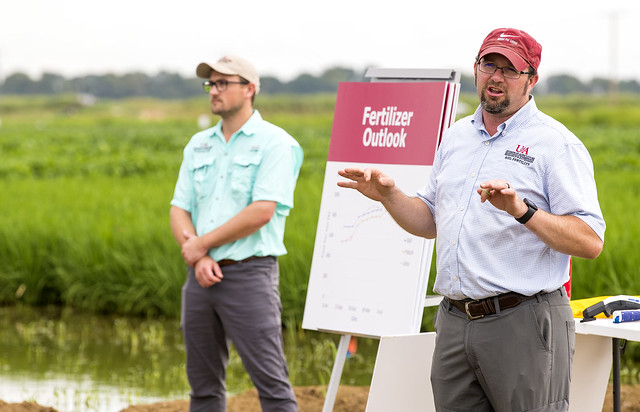Aug. 12, 2022
Soil nutrient replacement something to consider if burning, baling crop residue
By John Lovett
U of A System Division of Agriculture
Fast facts
- Estimated $275 worth of nutrients per acre in rice fields
- Decision Support Software like Potash Rate Calculator maximizes return of investment
- Volatility in market creates uncertainty on future nitrogen prices
(456 words)
Related PHOTOS: https://flic.kr/s/aHBqjA2cSQ
STUTTGART, Ark. — Farmers are standing on money in their field when it comes to soil nutrients.
With uncertainty in the market for fertilizer prices over the next year, a University of Arkansas System Division of Agriculture soil health expert advised producers at the 2022 Rice Field Day to consider the cost of replacing nutrients that will leave their field if they burn crop residue, or sell it for animal forage, after the harvest.
Trent Roberts, associate professor of soil fertility and soil testing, said one of the biggest questions he has received this year is about the value of crop residue. With drought conditions this year, row crop farmers are being asked by animal producers to take the crop residue off their hands for forage.
According to Roberts’ calculations, a 200-bushel-per-acre rice crop produces about 5 tons of residue worth about $275 per acre in nutrients. That would contain about $85 per acre in nitrogen, about $30 per acre in phosphorus, about $150 per acre in potassium, and about $10 per acre in sulfur.
“At some point you’re going to have to pay to replace that, so the question becomes are you going to get that cost from the person who is hauling off the hay or pay for it someday down the road,” Roberts said. “The biggest mistake you can do is give this residue away and not realize all of a sudden your soil test K starts dropping, your P test starts dropping and two or three years down the road you’re having to pay for these nutrients that you have given away.”
When burned, the nitrogen and sulfur are lost. With phosphorus and potassium, “wherever the ash goes is where that nutrient goes,” Roberts said. It may end up blowing away with the smoke, or washing down to the corner of the field, he added.
Knowing the right amount of fertilizer to keep from wasting money is also important. Roberts prompted producers to check out the Division of Agriculture’s Decision Support Software, including the Potash Rate Calculator, as tools to maximize yield and profitability. The software takes soil test results, yield potential and the price of fertilizer in consideration to provide recommended amounts of fertilizers.
Roberts said he expects mined nutrients like phosphorus and potash to remain high for the next 12 to 18 months. Nitrogen prices have been unpredictable because of unknown entities exiting from the market and driving prices down temporarily.
“We’re not sure who was not buying nitrogen fertilizer, but if the price of natural gas remains high and some of these unknown countries or unknown entities that typically buy fertilizer and took a year off jump back in the market once again, we could see those prices go up quite a bit.”
To learn more about Division of Agriculture research, visit the Arkansas Agricultural
Experiment Station website: https://aaes.uada.edu/. Follow us on Twitter at @ArkAgResearch.
To learn more about Division of Agriculture research, visit the Arkansas Agricultural
Experiment Station website: https://aaes.uada.edu. Follow on Twitter at @ArkAgResearch. To learn more about the Division of Agriculture,
visit https://uada.edu/. Follow us on Twitter at @AgInArk. To learn about extension programs in Arkansas,
contact your local Cooperative Extension Service agent or visit www.uaex.uada.edu.
About the Division of Agriculture
The University of Arkansas System Division of Agriculture’s mission is to strengthen agriculture, communities, and families by connecting trusted research to the adoption of best practices. Through the Agricultural Experiment Station and the Cooperative Extension Service, the Division of Agriculture conducts research and extension work within the nation’s historic land grant education system.
The Division of Agriculture is one of 20 entities within the University of Arkansas System. It has offices in all 75 counties in Arkansas and faculty on five system campuses.
Pursuant to 7 CFR § 15.3, the University of Arkansas System Division of Agriculture
offers all its Extension and Research programs and services (including employment)
without regard to race, color, sex, national origin, religion, age, disability, marital
or veteran status, genetic information, sexual preference, pregnancy or any other
legally protected status, and is an equal opportunity institution.
# # #
Media Contact: John Lovett
U of A System Division of Agriculture
Arkansas Agricultural Experiment Station
(479) 763-5929
jlovett@uada.edu
